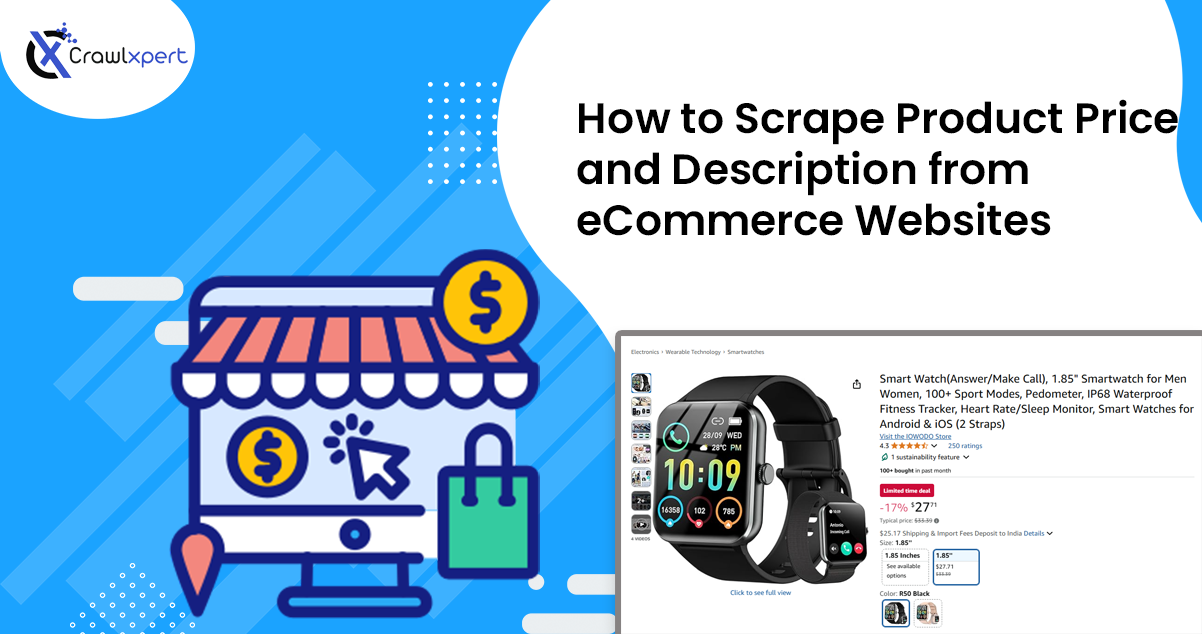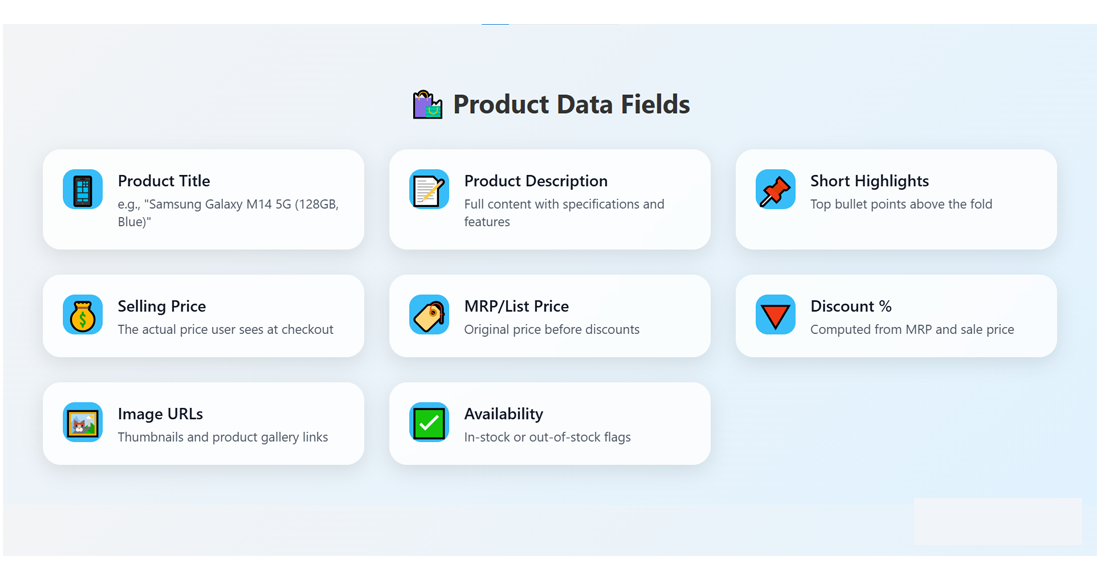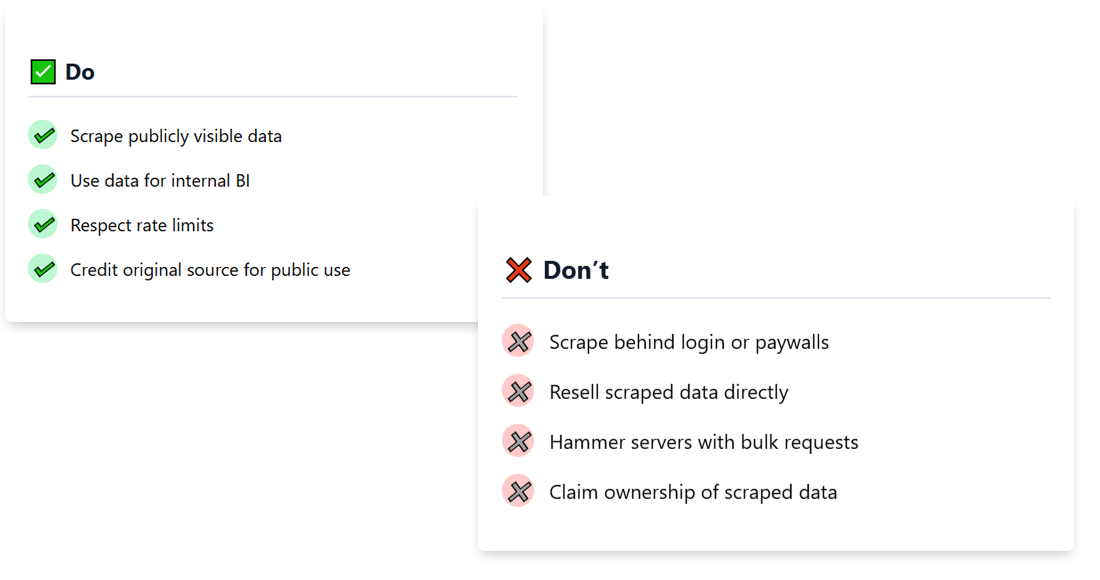
How to Scrape Product Price and Description from eCommerce Websites
Published on September 29, 2025
Introduction
Product pricing and descriptions are two of the most critical data points in the e-commerce ecosystem. From comparing competitor prices to analyzing product positioning, the ability to extract this information can offer a strategic advantage to sellers, marketers, and analysts alike.
Web scraping provides a systematic, automated way to collect product price and description data from online retailers such as Amazon, Flipkart, Walmart, and Shopify stores. This blog will walk you through the technical process, tools required, ethical guidelines, and real-world use cases for scraping product data from e-commerce websites.
1. Why Scrape Product Price and Description Data?
Here’s why businesses and developers use scraping to extract price and product content:
- Price Intelligence: Compare prices of similar SKUs across competitors to adjust pricing dynamically.
- Product Content Optimization: Analyze how top competitors write product descriptions to improve your own listings.
- SEO & Keyword Analysis: Evaluate keyword usage in titles, bullet points, and descriptions for content strategies.
- Assortment Comparison: Check which products, variants, or descriptions are missing from your store compared to others.
- Consumer Psychology: Detect patterns in how features, benefits, and technical specs are framed.

2. What Product Data Can You Scrape?
| Field | Description |
|---|---|
| Product Title | e.g., "Samsung Galaxy M14 5G (128GB, Blue)" |
| Product Description | Long-form content with features and specs |
| Short Highlights | Bullet points are often placed above the fold |
| Price (Selling) | Final checkout or offer price |
| MRP/List Price | The original price before the discount |
| Discount % | Discount computed from MRP and offer price |
| Image URLs | Links to product thumbnails and galleries |
| Availability Status | In-stock or out-of-stock flags |
3. Technologies Used in Web Scraping
To scrape eCommerce websites, you can use:
| Tool | Purpose |
|---|---|
| requests | For sending HTTP GET/POST requests |
| BeautifulSoup | For parsing static HTML content |
| Selenium | For handling JavaScript-rendered pages |
| Scrapy | For large-scale crawling |
| Playwright | For headless browser-based scraping |
| pandas | For structuring and exporting scraped data |
4. Step-by-Step: Scrape Product Price and Description with Python
Let’s walk through a real example: scraping product data from a sample static eCommerce site.
Note: Always review and respect each site’s robots.txt file. The following example is for educational purposes only.
Sample Python Script Using requests + BeautifulSoup
import requests
from bs4 import BeautifulSoup
import pandas as pd
headers = {
"User-Agent": "Mozilla/5.0"
}
url = 'https://example-ecommerce.com/product/12345'
response = requests.get(url, headers=headers)
soup = BeautifulSoup(response.text, 'html.parser')
product = {
'Title': soup.find('h1', class_='product-title').text.strip(),
'Price': soup.find('span', class_='price').text.strip(),
'Description': soup.find('div', class_='description').text.strip()
}
df = pd.DataFrame([product])
df.to_csv('product_data.csv', index=False)Replace tag classes like 'product-title' and 'price' with actual ones from your target site using Chrome DevTools.
Dynamic Sites: Use Selenium
from selenium import webdriver
from bs4 import BeautifulSoup
import pandas as pd
driver = webdriver.Chrome()
driver.get('https://www.amazon.in/dp/B0BZCSFM7F')
soup = BeautifulSoup(driver.page_source, 'html.parser')
title = soup.find('span', id='productTitle').text.strip()
price = soup.find('span', class_='a-offscreen').text.strip()
description = soup.find('div', id='feature-bullets').text.strip()
driver.quit()
data = {'Title': title, 'Price': price, 'Description': description}
df = pd.DataFrame([data])
df.to_csv('amazon_product.csv', index=False)5. Handle Anti-Scraping Measures
Many e-commerce sites have protections. Here’s how to overcome common issues:
| Problem | Solution |
|---|---|
| JavaScript content | Use Selenium or Playwright |
| Captchas | Use browser automation, or solve it manually |
| IP blocks | Use proxy rotation services |
| Changing HTML structure | Use regex or AI-based parsers |
6. Real-World Applications
| Use Case | Description |
|---|---|
| Price Tracker Tools | Build an app to track price drops automatically |
| Affiliate Marketing Insights | Track top-selling product content across niches |
| Retailer Benchmarking | Understand how competitors position their products |
| AI Chatbot Training | Feed eCommerce product data into conversational models |
| SEO Audit | Compare how competitors optimize descriptions |
7. Best Practices
- Always check if the data is public.
- Don’t scrape at high frequency—use delays.
- Identify yourself with a user-agent.
- Avoid scraping customer reviews or private details unless permitted.
- Cache repeated requests to reduce load.
- Use pagination logic to crawl category-level pages efficiently.

8. Legal and Ethical Considerations
Web scraping lies in a gray area. Here are general ethical guidelines:
| Do | Don’t |
|---|---|
| Scrape publicly visible data | Scrape behind login or paywalls |
| Use data for internal BI | Resell scraped data directly |
| Respect rate limits | Hammer servers with bulk requests |
| Credit original source if public use | Pretend the scraped data is yours |
Tip: Many platforms offer product APIs (affiliate APIs, open data feeds). Consider using those when available.
9. Advanced Use: Scraping at Scale
- Use a crawler framework like Scrapy
- Store data in MongoDB or PostgreSQL
- Use queues (Kafka, RabbitMQ) for task management
- Integrate with a dashboard (like Power BI) for real-time monitoring
- Build an alert system for price changes
10. Conclusion
Scraping product prices and descriptions from e-commerce sites provides a competitive edge in today’s data-driven retail environment. From optimizing pricing to crafting better content and outperforming competitors, it opens the door to smarter decision-making.
By using Python tools like BeautifulSoup or Selenium, you can automate the extraction of this high-value data while respecting ethical boundaries and usage policies.
So, whether you're building a price monitoring tool, a sales dashboard, or simply looking to gain deeper market insights, product data scraping is a powerful strategy to boost your e-commerce success.

